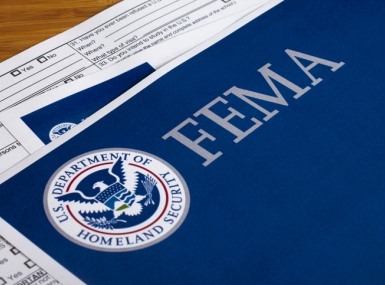Roundtable explores building disaster resilience
Upcoming Events
Related News

NACo resiliency roundtable focuses on how counties can bounce back easier, quicker, cheaper after a disaster
County leaders, federal officials and corporate partners met March 2 at NACo to discuss county-driven mitigation efforts that have made communities resilient to disasters.
“The issue of resilience is ready for prime time, and the Resilient Counties Initiative is working to build the momentum around this movement as we identify our path forward,” said James Gore, Resilient Counties Advisory Board chair and Sonoma County, Calif., supervisor.
The purpose of the roundtable discussion was to gain a better understanding of:
- programs and policies counties created to make it easier, cheaper and quicker to bounce back after a disaster
- how counties can better streamline procedures and utilize available resources, and
- how the Resilient Counties Initiative can support their efforts.
It is critical for counties to set themselves up for sustainable recovery before a disaster by establishing key partnerships and pre-disaster contracts, Gore said. In line with Federal Emergency Management Agency (FEMA) Administrator William “Brock” Long’s top priority, attendees discussed creating a “culture of preparedness” in which communication prior to a disaster leads to community well-being.
To prepare for disasters, county officials need to establish relationships at all levels of government and with all manners of partners, including the public, volunteer organizations, faith-based organizations, local businesses.
As Commissioner Darry Stacy from Cleveland County, Okla., pointed out: “You have to have relationships in place before an event so that you know who to reach out to for expertise when disaster strikes.” The federal partners in the room agreed. Leonard Jordan, associate chief for Conservation at the U.S. Department of Agriculture’s (USDA) Natural Resources Conservation Service, said, “USDA takes pride in collaborating, coordinating and capitalizing on the power one gets from collaborating. It’s about putting systems in place so we are not reactive.”
Discussion also centered on managing risk and knowing what resources — federal, corporate and non-profit — are out there. County governments fill the gaps between what federal government and industries provide post-disaster, so it is critical to understand the boundaries.
Attendees spent the majority of the roundtable discussing pre-disaster strategies, including: adopting new and updating old plans (hazard mitigation plans, continuity of operations plans), adopting new administrative land use and building code policies; undertaking hazard mitigation projects; putting assistance contracts and agreements in place pre-disaster and educating residents on basic preparedness principles, all major hazards and expectations for each.
Financially, Linda Langston, NACo director of Strategic Relations and former Linn County, Iowa supervisor, recommended that counties are prepared with adequate reserves and policies that allow for expedited financial decisions. Counties also need to understand duplication of benefits — multiple federal funds cannot be used on the same project — this is an area where some local governments get tripped up and must then pay the government back. Participants raised the issue of how to pay for pre-disaster mitigation projects. While FEMA has the Pre-Disaster Mitigation grant program, those resources are not enough. Counties often grapple with finding ways to pay for mitigation projects — especially counties with large amounts of federal lands on which federal dollars cannot be spent.
Commissioner Larry Schoen of Blaine County, Idaho, discussed preventative zoning and building codes his county has put in place, such as overlay districts and limiting development in high-risk areas. He recommends counties explore similar policy changes and plans and asked federal partners to continue to encourage and work with local governments to pursue pre-disaster mitigation measures.
Ryan Streeter, Intergovernmental Affairs specialist for FEMA, provided advice to counties looking to strengthen their partnership. First, he encouraged counties to understand the value of mitigation; per the recent National Institute of Building Sciences report (https://www.nibs.org/page/mitigationsaves), every $1 invested in hazard mitigation can save $6 in future costs. Second, he urged counties to consider the FEMA Hazard Mitigation Assistance Grant Program (https://www.fema.gov/hazard-mitigation-assistance), in particular the Pre-Disaster Mitigation grant program. Third, establish strong relationships with state departments of emergency management as local governments must work through the state to engage with FEMA; Fourth, FEMA is developing a National Mitigation Investment Strategy to increase the effectiveness of investments in reducing disaster losses and increasing resilience.
Beyond FEMA, Jordan mentioned USDA has resources to help prevent or deal with the aftermath of disasters. NRCS’ Environmental Quality Incentives Program provides financial assistance to repair and prevent soil erosion from rainfall and flooding. The agency’s Emergency Watershed Protection Program can assist local government sponsors with the cost of implementing recovery efforts like debris removal and streambank stabilization.
Stan Gimont, deputy assistant secretary for Grant Programs at the U.S. Department of Housing and Urban Development, emphasized the importance of the Community Development Block Grant Disaster Recovery grants to fund recovery activities. Gimont reinforced Sharpe’s point about the importance of where to put displaced residents as well as how to rebuild housing.
Participants discussed strategies for pre-disaster contracts, including: ensuring an inclusive competitive bidding process; educating local contractors on how to participate; and the value of adding clauses to the request for proposals and to the final contracts. To encourage local businesses, counties can include a clause asking people to explain their history and knowledge of the community. To ensure that the contractor does not move your county to the bottom of the list after a disaster – when it can sign on new local governments at a higher rate – include language that states your county will be prioritized. Streeter also recommends getting in touch with surrounding jurisdictions to prevent bidding wars.
More public dialogue around hazard mitigation plans is key, Gore said, while Schoen emphasized the importance of making the public aware of their responsibilities during a disaster.
NACo will continue this conversation as part of its Disaster Mitigation and Preparedness Social Media Day, sharing examples of accomplishments and resources. Join NACo Wednesday, April 11 at 2 p.m. ET on Twitter to showcase how your county has made investments in mitigation projects and has forged partnerships that have allowed you to recover from a recent disaster.
Attachments
Related News

States file lawsuit challenging FEMA’s new rules on emergency management grants
On November 4, a coalition of 12 states filed a lawsuit against the U.S. Department of Homeland Security (DHS) and the Federal Emergency Management Agency (FEMA), alleging that recent changes to key emergency management grants are unlawful and could disrupt state and local preparedness efforts.

County Countdown – Nov. 4, 2025
Every other week, NACo's County Countdown reviews top federal policy advocacy items with an eye towards counties and the intergovernmental partnership.
FEMA bill staffers offer insights into reform effort
NACo Intergovernmental Disaster Reform Task Force heard from staffers who helped shape a bill that would make dramatic changes to the Federal Emergency Management Agency.